
Durham, is a cathedral city and civil parish on the River Wear, County Durham, England. It is an administrative centre of the County Durham District, which is a successor to the historic County Palatine of Durham.
A county hall or shire hall is a common name given to a building that houses the seat of local government for a county.

Elvet is an area of the city of Durham, in County Durham, in England. It is situated on the opposite side of the River Wear from Durham Cathedral and forms the south-eastern part of central Durham. Elvet is currently unparished. Historically, the word elvet means "swan" or "swan-stream", from the Old English elfetu or ilfetu. The Swan and Three Cygnets, a public house on Elvet Bridge, is a reminder of the historical name given to this part of the city.

The Colleges of Durham University are residential colleges that are the primary source of accommodation and support services for undergraduates and postgraduates at Durham University, as well as providing a focus for social, cultural and sporting life for their members, and offering bursaries and scholarships to students. They also provide funding and/or accommodation for some of the research posts in the University. All students at the University are required to be members of one of the colleges.

Shire Hall is a building complex located in Northgate Street in Warwick, England. It is the main office and the meeting place of Warwickshire County Council. The complex is a Grade I listed building.

The Shire Hall is a municipal building in Fore Street, Hertford, the county town of Hertfordshire, England. The building, which currently serves as a Magistrates' Court, is a Grade I listed building.
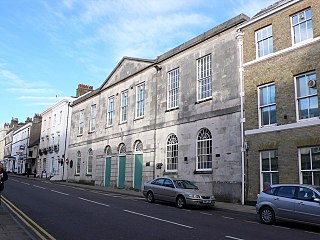
Shire Hall is an 18th-century courthouse in Dorchester, Dorset. The building was the centre of law, order and government, and served as the county hall for Dorset until 1955. It has been Grade I listed since 1950. In 2018, the hall opened as the Shire Hall Historic Courthouse Museum.

William James Morley FRIBA was an English architect who practised from offices in Bolton, Greater Manchester and Bradford, West Yorkshire.

The Shire Hall is a municipal facility in Tindal Square in Chelmsford, Essex. It is a Grade II* listed building.

County Buildings is a municipal facility at Martin Street in Stafford, Staffordshire. The building, which is the meeting place for Staffordshire County Council, is a Grade II* listed building.
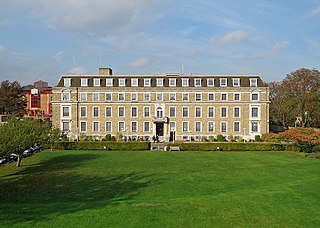
Shire Hall is a former municipal building in Castle Hill in Cambridge, Cambridgeshire, England. It was the headquarters of Cambridgeshire County Council from 1932 until 2021, when the council moved to New Shire Hall at Alconbury Weald, some 23 miles from Cambridge.

County Hall is a former municipal building, now used for student accommodation, in Hobson Street, Cambridge, Cambridgeshire, England. It is a Grade II listed building.

County Hall is a municipal building at Aykley Heads in Durham, County Durham, England. It is the headquarters of Durham County Council.
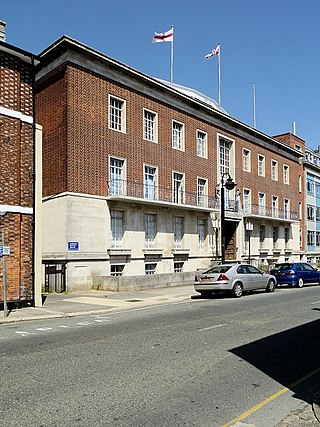
County Hall is a municipal building in High Street, Newport, Isle of Wight, England. It is the headquarters of the Isle of Wight Council.
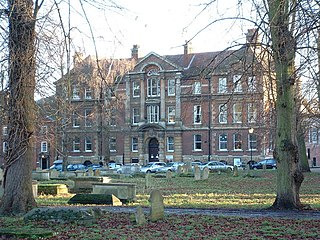
The Shire Hall Complex is a group of municipal buildings in Bury St Edmunds, Suffolk, England. The complex, which was the headquarters of West Suffolk County Council until its abolition in 1974, is a Grade II listed building.

The Shire Hall is a municipal structure in Glanhwfa Road, Llangefni, Anglesey, Wales. The building, which served as the headquarters of Anglesey County Council, is a Grade II listed building.

Helmsley Town Hall is a municipal building in the Market Place in Helmsley, North Yorkshire, England. The structure, which is used as a community library and a community events centre, is a grade II listed building.

Fenton Town Hall is a municipal building in Albert Square in Fenton, Staffordshire, England. It is now occupied by local businesses, a café and an art gallery.

Hanley Town Hall is a municipal building in Albion Square in Hanley, Staffordshire, England. The building, which is used as the local register office, is a Grade II listed building.
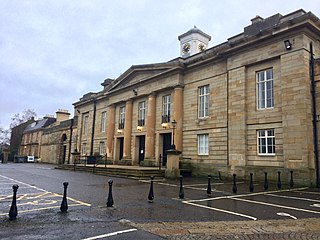
Durham Crown Court is a Crown Court venue which deals with criminal cases at Old Elvet, Durham, England. Located immediately to the north of Durham Prison, it is a Grade II* listed building.




















